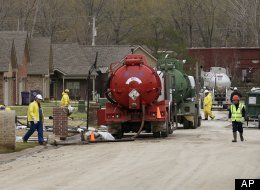
© AP Photo/Danny JohnstonCrews work to clean up from an oil pipeline spill in a Mayflower, Ark., neighborhood Wednesday, April 3, 2013.
It just keeps on getting worse for ExxonMobil and its major oil pipeline spill in Mayflower, Ark. This week, officials were bracing for
a major storm that threatened to send more of the spilled oil from the Canadian tar sands into nearby Lake Conway - a major, environmentally sensitive waterway:
Arkansas Attorney General Dustin McDaniel says he's concerned about the effect heavy rainfall could have on dispersing oil that spilled last month when an ExxonMobil pipeline ruptured at Mayflower.
McDaniel said Wednesday that he and other officials were watching the weather closely as storms raked parts of the state.
A severe thunderstorm hit the area Wednesday, but there were no immediate reports of weather-related incidents at the site where ExxonMobil Pipeline Co.'s Pegasus pipeline ruptured on March 29.
ExxonMobil and local officials say crews have secured equipment and strengthened a containment system to protect the main body of nearby Lake Conway.
But the sad reality is that no matter what the weather is in the state of Arkansas this week, major damage - the result of ExxonMobil's wanton recklessness - has already been done there.
And what's chilling is how many similarities we're seeing with this event to the horrific ways in which BP dealt with 2010′s Deepwater Horizon spill offshore. Just as happened in the Gulf of Mexico,
ExxonMobil has gone to over-the-top lengths to restrict public and media access, including absurd and hard-to-legally-justify flight restrictions. And of course - exactly as BP had done three years earlier -
ExxonMobil also tried to greatly underplay the extent of environmental damage. The truth is that the authorities still have no idea how much of the oil was actually spilled:
An ExxonMobil pipeline that ruptured last month and spilled thousands of barrels of oil in central Arkansas has a gash in it that is 22 feet long and 2 inches wide, state Attorney General Dustin McDaniel said Wednesday.
"The pipeline rupture is substantially larger than many of us initially thought," McDaniel told reporters Wednesday evening.
McDaniel's update on the March 29 oil spill in Mayflower, about 25 miles northwest of Little Rock, comes as lawyers and investigators review more than 12,500 pages of documents his office received from ExxonMobil. McDaniel sent a subpoena to ExxonMobil, seeking inspection records, investigative documents and maintenance records related to its Pegasus pipeline that ruptured in Mayflower.
But here's the similarity that concerns me the most: Just as BP's unchecked oil made many folks along the Gulf Coast ill,
there are early reports of Mayflower residents who are feeling ill and are worried that ExxonMobil is to blame.
Sherry Appleman awoke abruptly in the middle of the night less than 48 hours after a pipeline rupture last month sent thousands of barrels of heavy crude oil into the streets and swamps of Mayflower, Ark.
"I couldn't breathe. My throat and nose and eyes were burning really bad," recalled Appleman, who lives on Lake Conway, about a mile outside the 22-home evacuation zone - but next to a slough now full of the thick, sticky diluted bitumen. "I could smell that horrible smell. I got really scared."
After nine days of headaches, stomachaches and a persistent sore throat, Appleman's sleep was disturbed again on Monday night by what she perceived as a "strange noise" coming from the lake. She spotted three guys in a boat equipped with a computer and large video screen netting several dead fish from the popular fishing spot. According to Appleman, the men ignored her questions and shined a spotlight on her as she tried to take pictures from the shore with her iPhone.
"I can't figure out half of the stuff that is going on," said Appleman. "They haven't given us any answers."
We all need a lot more answers at this point. The oil spill has released toxic chemicals such as benzene, hydrogen sulfide, toluene into the air - in concentrations powerful enough that eight elementary school children were sent home earlier in the week. There are still unanswered questions about how much of the oil has tainted local wetlands and possibly Lake Conway itself. Many environmental advocates - myself included - have called attention to how this spill is essentially the exclamation point on the argument against the much larger Keystone XL pipeline project. That's true, but before we worry about that, we really need to worry about the immediate situation in Mayflower, Ark. - and whether things there are even under control.




Reader Comments
to our Newsletter